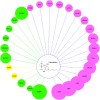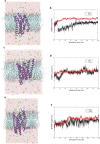Computational systems pharmacology analysis of cannabidiol: a combination of chemogenomics-knowledgebase network analysis and integrated in silico modeling and simulation
- PMID: 30202014
- PMCID: PMC6460368
- DOI: 10.1038/s41401-018-0071-1
Computational systems pharmacology analysis of cannabidiol: a combination of chemogenomics-knowledgebase network analysis and integrated in silico modeling and simulation
Abstract
With treatment benefits in both the central nervous system and the peripheral system, the medical use of cannabidiol (CBD) has gained increasing popularity. Given that the therapeutic mechanisms of CBD are still vague, the systematic identification of its potential targets, signaling pathways, and their associations with corresponding diseases is of great interest for researchers. In the present work, chemogenomics-knowledgebase systems pharmacology analysis was applied for systematic network studies to generate CBD-target, target-pathway, and target-disease networks by combining both the results from the in silico analysis and the reported experimental validations. Based on the network analysis, three human neuro-related rhodopsin-like GPCRs, i.e., 5-hydroxytryptamine receptor 1 A (5HT1A), delta-type opioid receptor (OPRD) and G protein-coupled receptor 55 (GPR55), were selected for close evaluation. Integrated computational methodologies, including homology modeling, molecular docking, and molecular dynamics simulation, were used to evaluate the protein-CBD binding modes. A CBD-preferred pocket consisting of a hydrophobic cavity and backbone hinges was proposed and tested for CBD-class A GPCR binding. Finally, the neurophysiological effects of CBD were illustrated at the molecular level, and dopamine receptor 3 (DRD3) was further predicted to be an active target for CBD.
Keywords: 5HT1A; D3; cannabidiol (CBD); cannabinoid; homology modeling; molecular docking; molecular dynamics simulation; systems pharmacology.
Conflict of interest statement
The authors declare no competing interests.
Figures









Similar articles
-
Determination of the Negative Allosteric Binding Site of Cannabidiol at the CB1 Receptor: A Combined Computational and Site-Directed Mutagenesis Study.ACS Chem Neurosci. 2025 Feb 5;16(3):311-328. doi: 10.1021/acschemneuro.4c00343. Epub 2025 Jan 15. ACS Chem Neurosci. 2025. PMID: 39812521
-
Fatty acid-binding proteins (FABPs) are intracellular carriers for Δ9-tetrahydrocannabinol (THC) and cannabidiol (CBD).J Biol Chem. 2015 Apr 3;290(14):8711-21. doi: 10.1074/jbc.M114.618447. Epub 2015 Feb 9. J Biol Chem. 2015. PMID: 25666611 Free PMC article.
-
Allosteric Modulation of the CB1 Cannabinoid Receptor by Cannabidiol-A Molecular Modeling Study of the N-Terminal Domain and the Allosteric-Orthosteric Coupling.Molecules. 2021 Apr 23;26(9):2456. doi: 10.3390/molecules26092456. Molecules. 2021. PMID: 33922473 Free PMC article.
-
Diversity of molecular targets and signaling pathways for CBD.Pharmacol Res Perspect. 2020 Dec;8(6):e00682. doi: 10.1002/prp2.682. Pharmacol Res Perspect. 2020. PMID: 33169541 Free PMC article. Review.
-
Unraveling the Mechanisms of Cannabidiol's Pharmacological Actions: A Comprehensive Research Overview.Top Curr Chem (Cham). 2024 Jun 3;382(2):20. doi: 10.1007/s41061-024-00465-w. Top Curr Chem (Cham). 2024. PMID: 38829467 Review.
Cited by
-
Practical Considerations for the Use of Cannabis in Cancer Pain Management-What a Medical Oncologist Should Know.J Clin Med. 2022 Aug 27;11(17):5036. doi: 10.3390/jcm11175036. J Clin Med. 2022. PMID: 36078963 Free PMC article. Review.
-
Insights about multi-targeting and synergistic neuromodulators in Ayurvedic herbs against epilepsy: integrated computational studies on drug-target and protein-protein interaction networks.Sci Rep. 2019 Jul 22;9(1):10565. doi: 10.1038/s41598-019-46715-6. Sci Rep. 2019. PMID: 31332210 Free PMC article.
-
Cannabidiol inhibits methamphetamine-induced dopamine release via modulation of the DRD1-MeCP2-BDNF-TrkB signaling pathway.Psychopharmacology (Berl). 2022 May;239(5):1521-1537. doi: 10.1007/s00213-021-06051-y. Epub 2022 Jan 8. Psychopharmacology (Berl). 2022. PMID: 34997862
-
A Network Pharmacology Approach to Identify Potential Molecular Targets for Cannabidiol's Anti-Inflammatory Activity.Cannabis Cannabinoid Res. 2021 Aug;6(4):288-299. doi: 10.1089/can.2020.0025. Epub 2020 Jul 1. Cannabis Cannabinoid Res. 2021. PMID: 33998855 Free PMC article.
-
Artificial Intelligent Deep Learning Molecular Generative Modeling of Scaffold-Focused and Cannabinoid CB2 Target-Specific Small-Molecule Sublibraries.Cells. 2022 Mar 7;11(5):915. doi: 10.3390/cells11050915. Cells. 2022. PMID: 35269537 Free PMC article.
References
MeSH terms
Substances
Grants and funding
LinkOut - more resources
Full Text Sources
Other Literature Sources

